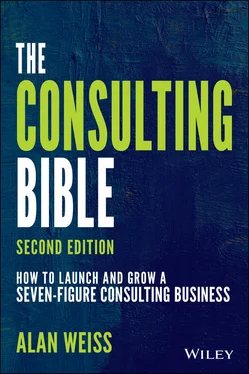1 Whose budget will support this initiative?
2 Who can immediately approve this project?
3 To whom will people look for support, approval, and credibility?
4 Who controls the resources required to make this happen?
5 Who has initiated this request?
6 Who will claim responsibility for the results?
7 Who will be seen as the main sponsor and/or champion?
8 Do you have to seek anyone else's approval?
9 Who will accept or reject proposals?
10 If you and I were to shake hands, could I begin tomorrow?
There are often, among the non‐buyers, key recommenders who can speed your efforts to find the economic buyer. It's worth developing brief relationships with such people in order to have someone lower the drawbridge over the moat.
It's easy to develop long‐term relationships with nonthreatening non‐buyers, but this results in nonpayment of your mortgage.

FIGURE 3.2Consulting Model
It's worth revisiting our consulting model chart (see Figure 3.2).
We begin with shared values—not spiritual or religious values, but business values. For example, I won't participate in downsizing work, because I believe it's unethical and the result of errors (and sometimes stupidity) in the executive suite. That's me; others may disagree. But I turn that work down based on differing values.
If values are simpatico, then we forge a relationship with the economic buyer. And that requires finding the economic buyer, which is why we've taken the time to examine that process here.
The next step is developing conceptual agreement, which is the very heart of my consulting model, but can be accomplished solely with an economic buyer . Only buyers can sign proposals (the following step in the model), and only they can provide the details that will make the proposal of high value and justify your fees.
Most consultants stumble in trying to find the economic buyer and settle for lower levels because of self‐esteem issues, feelings that they don't deserve or don't merit the attention of a key executive.
Get over it.
How do you know if you have a “trusting relationship” with a buyer?
The buyer doesn't allow for interruptions by phone, e‐mail, or assistant.
The buyer doesn't end the meeting early and might even extend it.
The buyer asks for advice on an issue.
The buyer reveals something confidential (“We're considering an expansion… .”)
The buyer uses humor and reacts well to your humor.
You are involved in a conversation, not a “presentation.”
No other people have been unilaterally invited to the meeting.
Once you've developed a trusting relationship with the economic buyer, you're positioned to establish conceptual agreement. We're in the middle of the chart, the sweet spot, and ironically, the longer you take to develop a relationship and create conceptual agreement, the quicker you'll obtain projects .
I know that sounds counterintuitive, but I simply mean this: The steps are rational in their sequence: No one is going to trust you with their objectives, for example, if they don't trust you , and you can't submit a proposal (the following step to conceptual agreement) without a congruence in the buyer's and your expectations and perceived value. (Nor can you arrive at an equitable fee.)
Conceptual agreement has three aspects: objectives, measures of success (metrics), and value.
There are always business outcomes, never deliverables or inputs. They describe a component of an improved client condition . Hence, these cannot be inputs, because a training program or a focus group does not improve the client's condition, per se ; it merely costs money! (You'll find that most gatekeepers and HR people talk solely in terms of inputs, and almost all RFPs are predefined inputs, e.g., a four‐day strategy retreat and a safety audit.)
Examples of objectives might include:
Reduce closing time for the average sale.
Improve client reorder size and frequency.
Reduce stress levels and resultant absenteeism.
Note that objectives can be both professional and personal, and can be tangible or nontangible. You derive objectives from the buyer by asking intelligent questions, and not stopping until you have plumbed all available responses. Here are 10 examples of questions:
1 What is the ideal outcome you'd like to experience?
2 What results are you trying to accomplish?
3 What better product/service/customer condition are you seeking?
4 Why are you seeking to do this work/project/engagement?
5 How would the operation be different as a result of this work?
6 What would be the return on investment (sales, assets, equity, etc.)?
7 How would image/reputation/credibility be improved?
8 What harm (stress, dysfunction, turf wars, etc.) would be alleviated?
9 How much would you gain on the competition as a result?
10 How would your value proposition be improved?
Hint: If a buyer does give you an arbitrary input or deliverable, simply ask why it's important and what it's supposed to produce. Asking “Why?” raises the level of decision to the real outcomes desired. (Asking “How?” lowers the level of decision to implementation, which is premature here.)
Note: Behind every corporate objective is a personal objective. If the business objective is to reduce attrition, the personal objective might be to focus on strategy and stop interviewing so many candidates. Better teamwork might be desired because the buyer is weary of playing “referee” among the teams .
The second aspect of conceptual agreement is metrics, that is, the indicators or measures of progress and/or completion. This is important so that both you and the buyer can judge relative success at any given time, and the success that occurs is attributable to your contributions in the project . This is vital to demonstrate ROI and justify fees.
Examples of metrics might include:
Sales reports showing rapidity of sales closing after first contact.
Quarterly sales totals of client reorders and rapidity.
Anecdotal reporting of stress levels at meetings and absentee reports submitted weekly.
Note that these can be both objective (based on empirical evidence) and subjective (based on perceptions and observed behavior) . That's fine, as long as you and the buyer both agree on who will do the anecdotal reporting.
Questions to develop metrics may include the following 10 inquiries:
1 How will you know we've accomplished your intent?
2 How, specifically, will the operation be different when we're done?
3 How will you measure this?
4 What indicators will you use to assess our progress?
5 Who or what will report on our results (against the objectives)?
6 Do you already have measures in place you intend to apply?
7 What is the rate of return (on sales, investment, etc.) that you seek?
8 How will we know that the public, employees, and/or customers perceive it?
9 Each time we talk, what standard will tell us we're progressing?
10 How would you know it if you tripped over it?
Hint: If the buyer isn't sure of a measure, ask, “How do you know the quality or performance is not present now, and how would you know when it does occur?” or: “What is the condition causing you pain now that you would like to remove and how would you know it's gone?”
Читать дальше













